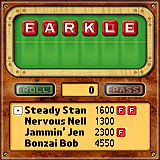
Farkle is an ages-old dice game. It has the advantage that it can be played with just a set of 6 dice and some paper for scoring. It requires no cards, the counting is easy, and it can be taught in just a few minutes. It also requires a great deal of strategy. Farkle is a game of chance played with dice and is similar to Yahtzee, but with a few twists.
Farkle is also known as: Five Thousand, Zilch, Farkel, Ten Thousand, Snap, Kaput, Dix Mille (French), Cosmic Wimpout (five dice), Pass the Pigs (played with pigs instead of dice), Keepers (Australian, 5 dice), Forkle, Blewit, Double Cameroon (10 dice) and 5000 Progressive.
Farkle has been a favorite game of mine for years. My family and I have played the game often at the dining room table. I was excited to find out that Smart Box Design had created a Farkle game for mobile devices. I've been playing the game on my Palm Treo 750. You can also get Farkle for your Palm OS smartphone.
Design
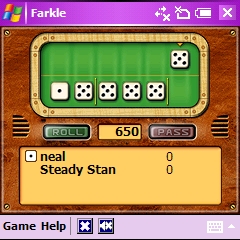
From the first look, one can tell that Smart Box Design put quite some effort into making Farkle Dice look as realistic as possible for mobile devices. As mentioned previously, I tested Farkle on a Palm Treo 750, and the game looks great on the 750's 240x240 screen. The system requirements for Farkle are that you have at least Windows Mobile 5.0, Windows Mobile 2003, and a 240 x 240 or higher display.
The table itself resembles a plush green craps table surrounded by a wood grain finish with rivots, and to either side of the table are what looks to be a speaker port. When you roll the dice, you are presented with a representation of dice rolling across the table, accompanied by a distinctive sound. The dice you hold are pushed/pulled to your hold section and you hear the di/dice sliding across the felt as you choose them.
When it's your turn to roll, you simply tap the green "Roll" button which is lit up to the bottom left of the table. After you roll, scoring dice are indicated by what appears to be orange arrows above the dice pointing down at them. When you wish to score the current points, you click the red "Pass" button to the bottom right of the table. When you farkle, you're presented with the word FARKLE in caps, each letter on one of the 6 dice (red dice) and you lose your turn. The graphics, sound effects and animation are great on Farkle. I enjoy watching the dice rolling and hearing the cute sounds they make when they roll.
Set Up
Farkle Dice has a free trial that is available for download here. You can also choose the "Install Now" option and have the necessary data sent to your phone by SMS or to your chosen E-mail box.
Once set up, be prepared for hours, maybe DAYS, of fun!!
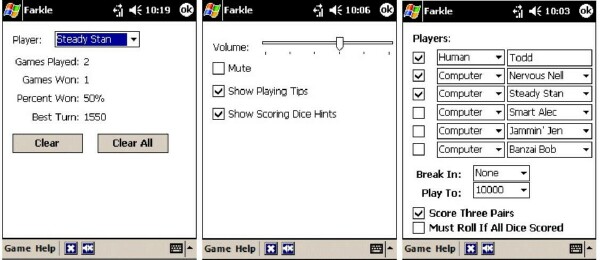
You can customize many aspects of the game by choosing the "Game" menu on the bottom left of your screen. By chosing Preferences, you can set the volume of the game, mute the sound completely, choose whether or not to show scoring dice hints and playing tips or set the speed of the game. I'd recommend the normal or slow setting for speed because it's hard to follow the computer opponents on fast and the rolling dice aren't as enjoyable to watch. When set on "Fast", the dice roll so fast that they're almost blurred. Plus everything moves so quickly that you can't really keep up with the particular choices that your opponent makes.
You can set the break-in score needed to begin actually counting what scoring dice you roll and set the goal to play to to either 5000 or 10000. If you only have time for a quick game, you could set the break-in score for 500 so you can get on the board faster. You can also choose whether or not to allow the scoring of three pairs, which I'll touch on later in my review. Lastly in the Game Setup menu, you can choose whether or not the players HAVE to roll if all of the dice are scoring dice.
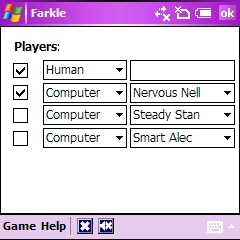
By selecting Choose Players from the Game menu you can choose to either play against up to 3 other human opponents or choose up to 3 of the 8 computer opponents. You can register the game by selecting Register from the Game menu and by choosing Purchase Info, you are presented with Smart Box Designs Web address. You may also quit the game from the Game menu.
There is a built-in Help menu with a "How to Play" menu from which you can choose to read how to play Farkle; how the scoring works and some basic strategies for the game itself. This is very helpful for those who have never played Farkle before and well worth the time to read through as it explains the sub-menus in the game.
Rules
Farkle players play against each other or against computer opponents. Like Yahtzee, points are awarded for particular combinations of dice, but in Farkle, there is no one-time only rolls in which you have to achieve to score each round.
Whether it be against human opponents or against the A.I. capable computer opponents, Farkle Dice for the Palm is a great rendition of a game sure to be a classic!
Farkle's rules are fairly easy to learn. You might have to play a few rounds before you get used to the rules, but Farkle is an easy and fun game to catch on. Below are the Farkle "Rules":
- Be the first to reach the set goal of either 5000 or 10000
- You can set the break-in score to one of five different settings: None, 350, 500, 750 or 1000 points (you must roll at least that much on a roll to actually begin counting your scoring rolls).
- You can play against up to three other components, be they human or computer-controlled.
- Players in turn roll six dice, trying to throw ones, fives, 3 of a kind, 3 sets of pairs, or a straight (1, 2, 3, 4, 5, and 6).
- Farkle: throwing dice and coming up with no points. If a player gets a Farkle three turns in a row, then 1,000 points is deducted from their score.
- After each throw, the player must set aside at least one scoring die. Then the player has two choices: either stop rolling and take their points, or continue to roll and risk their accumulated points for that turn. If a player scores points with all of the dice, they may stop, or continue by throwing all 6 dice.
SCORING
The potential scoring combinations are as follows:
- 1's count as 100 points each
- 5's count as 50 points each
- Three 1's count 1000 points
- Three 2's count 200 points
- Three 3's count 300 points
- Three 4's count 400 points
- Three 5's count 500 points
- Three 6's count 600 point
- A straight (1-6) counts 1000 points
When you're playing Farkle in real life with actual dice, someone is usually designated to keep score. Luckily, when playing Farkle on your Treo, you don't have to keep score because the game does that for you. So no need to waste scraps of paper and look for a pen or pencil.
Keep in mind that you can check your playing statistics or those of friends or the computer opponents at any time from the Game menu (and reset them if you've done poorly. (hehe).
Let the game begin!
I chose to play against the computer, as this is what I believe the game is geared towards
When playing Farkle, you don't have to remember a lot of Treo button pushes because all you really need is your stylus. You simply tap on "Roll" and tap on which dice you choose to hold. The table is horizontally divided by a light yellow line. The dice that you choose to hold immediately go down to the lower portion of the table. When you're ready to pass to the next player, just tap on the "Pass" button. There are eight computer opponents to choose from and I chose the first listed player, Nervous Nell. The computer opponents names give away their personalities. For example, Nervous Nell is a "nervous" player who is afraid of taking chances.
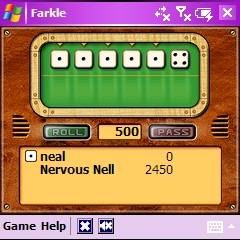
Game play was quick and the sounds and graphics were pleasing to the eye/ear. I farkled my first turn and failed to meet the 1000 point break-in score I set for the game. Nell quickly got on the board her first roll, and scored nicely her second round and the game was on! I managed to total to 500 my next turn and rolled all six dice again and rolled FIVE 1's and a 4!
Not a bad turn. I played cautiously at first, taking few chances and built my score up steadily. Again, Nell followed suit, and the game was pretty much even up until I had a score of 8,350. Here, Nell took what I considered to be unneccesary chances and fell behind, farkling three times and hence losing 1000 points. I rolled and scored enough to put me over the required 10000 points to win the game and Nell failed to catch me or surpass me and I won the game. (See my notes about Nervous Nell in the quirks section)
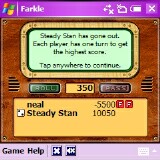
Next, I decided to try my luck against Steady Stan. Steady Stan is just that - steady and predictable. You need to score your dice, taking selected risks if you intend to beat him. I was toying with Stan my first game and he beat me handily LoL!! (See screenshot left).
Of note, Bonzai Bob is one crazy computer-controlled player! I couldn't figure out the logic behind him; perhaps there is none?! Bonzai Bob had three 3's, two 5's and a 2 and kept one 5 and rolled instead of scoring 400 for the 3's and the two 5's (and farkled on that roll btw). Again, I toyed with Bonzai Bob and was behind by nearly 4600 points after farkling purposely..umm.. a few times and the computer 'helped' me a bit. The screenshot below shows my one round tally of over 3900 points!!

I spent around three hours playing the various computer opponents and, quite honestly, loved every minute of it.
The quirks
In addition to some rather odd scoring choices by the computer opponents, there were some scoring and game-play flaws I noticed.
If you set the game to 'Score Three Pairs', there are times when you are forced to take 500 points when the dice could be scored as higher. For example, I rolled two 4's and four 6's. I wanted to score this as 600 points (600 for the three 6's), but was forced to score it as three pairs, which only gave me 500 points.
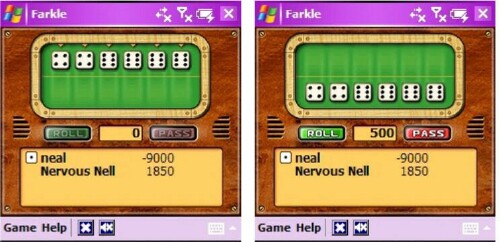
Also, if you change the break-in score or change your opponent(s), many times when you reach the break-in score the first game, you can't 'Pass' to count the score. In fact, I was unable to break-in at all, even when my one-turn score surpassed 3000 points. Restaring the game fixes it for further games.
One last note about Nervous Nell. I was curious and played Nervous Nell and when I did break in, I purposely farkled each and every roll to see how the game would pan out. Nell broke in and scored normally, then, suddenly, she began taking chance after chance and farkling herself. I kept this up until my score was -9000, and when I farkled three more times, the game abruptly errored out and I received the familiar 'send the error to Microsoft' pop-up.
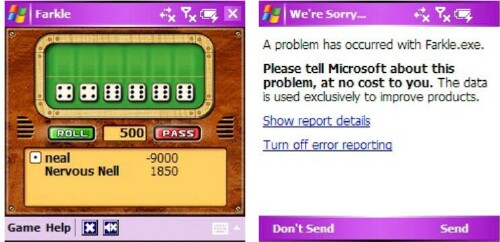
Conclusion

The most enjoyable thing about Farkle, to me anyway, is falling behind and then suddenly putting together a good string of rolls and scoring two to three thousand points and forging ahead in the score! This is what makes Farkle so addictive - that huge turn could always be just one roll away! I believe that is why Farkle is such an immensely popular game.
Farkle Dice by Smart Box Design is a fairly solid rendition of the game of Farkle. It's great to be able to play such a fun game on my Treo after playing it for so long with real people and real dice. The high resolution graphics, animations, and distinct sound effects, along with the various and distinct playing habits of the computer opponents are enough to hold one's interest in the game longer than most games for the Treo I have played. Sure, there are what I perceive as small logic errors that can detract from the enjoyment of the game occasionally, but overall - I absolutely love this game!!
If you want a serious challenge, stay away from Nervous Nell, and play Steady Stan or Smart Alec. The computer players each have their own unique AI, which emulates the different playing styles of different human opponents you may face.
Farkle is an excellent game that never gets boring, and $14.95 is a fair price for hours and hours of endless fun. Why not download the trial today? Prepare to become addicted!
|
|
| Pros |
Great graphics
Easy to learn, but tough to put down
Great way to pass the time
Customizable game settings
Very addictive
Cool sound effects
|
|
| Cons |
Would be nice if you could play other people via Bluetooth
Illogical play by the computer opponents
Flawed logic in some dice combinations
|
|